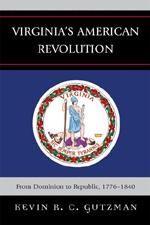Today is the 232nd anniversary of the inauguration of the American Revolution. It was on May 15, 1776 that Virginia’s ruling revolutionary May Convention adopted the resolutions that Virginians understood, according to young James Madison, as launching the ship of independence.
The first of the Virginians’ resolutions called for the adoption of a declaration of rights. The committee appointed to draft that declaration, chaired by George Mason of Gunston Hall, soon reported a document establishing the Lockean foundation of Virginia’s assertion of home rule. All men are born free and equal, it said, and when they enter into a state of society, they cannot be deprived of their basic rights.
The balance of the Declaration of Rights was devoted to explaining the relationship between citizens and government and to enshrining some of the basic rights of Englishmen, such as the right to trial by jury and the right to have militia, not professional soldiers, be the government’s first recourse.
The Avalon Project of Yale University has helpfully posted the final version of the Declaration of Rights of 1776 online. In doing so, however, it mistakenly identifies Mason as the Declaration’s draftsman. Although Mason did the lion’s share of the work, there were two important areas in which the final text was a product of the entire Convention.
First, at the beginning, Mason would have had the Declaration state simply that men are born free and equal and that they cannot be deprived of certain basic rights. When his committee reported its draft to the full Convention, however, it met the objection that such a pious statement either would soon yield social convulsion (in case it were actually implemented by an abolition of slavery) or, in being ignored, would teach Virginians not to respect their Declaration of Rights. That is why the Convention added the caveat that when they enter into a state of society, men cannot be deprived of their rights. The slaves were not entering into the Lockean compact that was creating republican Virginia.
The other change to Mason’s handiwork came in the final provision. Mason, a self-described "Man of 1688" (the Glorious Revolution), had said that Virginians were entitled to the fullest "toleration" in matters of religion. Madison objected to this language, noting its implication that the state knew best. His alternative proposal was that Virginians were to enjoy the "free exercise" of religion. The house, including Mason, agreed.
Thus began the American tradition of declarations of rights. The work of George Mason and his colleagues would serve as a template for other states’ declarations of rights, for the French Declaration of the Rights of Man and Citizen (Virginian Thomas Jefferson helped his friend the marquis de la Fayette in the composition, so it is unsurprising that some of the French provisions were virtual translations of the Virginian versions), and, through the influence of French law, of those of former French colonies around the world. Ultimately, several of the Virginian ideas made their way into the UN version.
This was not the most important work of the May Convention, however, but only its prelude. Next came the real work: adopting a permanent republican constitution. Like the other colonies, Virginia had been arguing for years that its sole legal link to Great Britain was through the Crown. Virginia patriots said that their House of Burgesses should have the primary role in the government and repeatedly ran off royal governors whose policies or personalities they found unacceptable. According to them, their colonial constitution was a mirror image of Britain’s, and so their 1776 constitution established a very similar government.
The Virginia Constitution of 1776 was the first written constitution adopted by the people’s representatives in the history of the world. Beyond the fact that it was a written constitution, there was, as anyone who knew Mason might have predicted, basically nothing innovative about it. The first governor of republican Virginia, Patrick Henry, took the oath of office on June 29, 1776.
How significant were these events? Congressman Thomas Jefferson repeatedly wrote home while it was being drafted to ask to be relieved of his congressional duties. As he explained it, this was what the war was about; it would be better to have the poor constitution the British were trying to force on the colonies without a fight, he said, than to win the right to force a bad one on themselves.
When the Convention’s leaders omitted to send someone to take his place, Jefferson sent a proposed constitution to Williamsburg for the Convention’s consideration. It arrived too late to have much influence, but the Convention did use Jefferson’s preamble. Poor Jefferson, for his part, had to content himself with staying in Philadelphia and drafting the Declaration of American Independence.
In one of the classic cases of sour grapes in American history, Jefferson spent the rest of his life complaining that the Constitution of 1776 was illegitimate. It had been adopted, he insisted, by a body that had not been given power to adopt a constitution. Never mind that the Convention’s leadership, including Henry and Mason, had considered this argument and rejected it. (If the Convention had the power to declare independence, they reasoned, it obviously must have power to replace the king’s government with something else.)
In time, Virginia would adopt a more Jeffersonian constitution. Whether that document was superior to its predecessor is debatable. What is not is that Virginia’s example continues to inspire the world.





